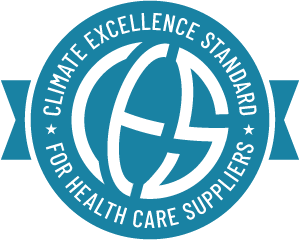The Climate Excellence Standard defines superior performance in decarbonization on the part of individual suppliers – including manufacturers and distributors – to ensure the health care supply chain is aligned with achieving net-zero emissions by 2050, while improving resilience. Reducing the health care sector’s reliance on fossil fuels is critical for reducing deaths and diseases related to greenhouse gas emissions, and the time is now for deep engagement across the supply chain.
Purpose and use:

Use of the standard will include showcasing suppliers that attain climate excellence status, giving them visibility at events and publications, and highlighting the collaborations that make advancements possible. By featuring successes by health care leaders, we will accelerate momentum to decarbonize the sector, ultimately influencing the broader economy.
Health systems and their group purchasing organizations may embed some or all of the requirements into requests for information, requests for proposals, or contracts so product or supplier selection is informed by emissions performance.
Supplier performance will be verifiable through publicly accessible websites.
This standard will be updated periodically to align with rapidly evolving developments in supply chain decarbonization, ensuring that it continues to define the standard for excellence.
Requirements of the Climate Excellence Standard
Phase 1 (2023-2025):
- Emissions target and plan has been submitted to the Science Based Target Initiative (SBTi) for approval, or the company has an SBTi-approved plan with near-term or long-term targets, OR
- Publicly commit to a near-term or long-term science-based emissions reduction target as defined by SBTi, and
- Measure Scopes 1, 2, and 3 emissions using the Greenhouse Gas Protocol, and
- Disclose emissions through CDP, EcoVadis, or similar publicly accessible and recognized platforms (disclosures only on suppliers’ corporate websites do not meet this criteria), and
- Assure Scopes 1 and 2 emissions data through a third-party verifier.
AND
- Minimize use of carbon offsets to only those emissions that currently do not have a realistic, practical solution. Applicable through 2025 only.
- Prepare and execute a publicly available plan to reduce operational emissions (Scopes 1 and 2) and the most relevant Scope 3 categories (e.g., emissions from staff commuting, waste, and business travel).
- Incentivize major vendors or subcontractors that reflect at least 20% of spend to commit to a science-based target along with the other requirements described in this section.
Phase 2 (effective in 2026):
The standard will be revisited in collaboration with suppliers and health systems to consider and further develop these and other provisions to be effective in 2026.
- Continue to meet the requirements of Phase 1, and
- Provide the date when the supplier will have a publicly available SBTi-aligned plan to limit the use of offsets to residual emissions (not to exceed 10%).
- Provide emission factors associated with the company’s top-selling products representing 20% of revenue within each business unit by 2028.
- Reduce single-use fossil fuel plastics in health care by offering sustainable, non-toxic products that are part of a circular system keeping materials in use while regenerating natural systems.
- Prepare, execute, and make publicly available resilience plans with climate and environmental considerations. Plans should build in considerations to produce and deliver products with minimal disruption due to man-made or natural disasters. Incorporate climate resilience tactics into annual strategic decision-making, policies, pay bonuses, and the organization’s mission statement.
- Reduce transportation emissions across the supply chain through solutions including electric fleets, optimized logistics, and partnering with purchasers to reduce trips.
- Publicly release an annual disclosure of all major actions taken by your organization to create a sustainable, closed-loop, and climate-resilient supply chain.
The U.S. Health Care Climate Council established this standard to use its considerable purchasing power to signal to the market the need for significant progress in addressing the severe human health consequences of climate change. By acting collectively, the Council can achieve greater visibility for targeted actions to address supply chain opportunities, while committing to collaborate with suppliers to accelerate decarbonization. By decarbonizing, suppliers enhance their operational resilience and competitive advantage. Practice Greenhealth encourages all health systems to engage with their vendors to see if they meet the Phase I criteria of Climate Excellence Standard or if they plan to meet the standard in the near future.
